‘Serviam – I Will Serve’ Review: The Nuns Are At It Again in a Chic, Creepy But Stifled Austrian Art-Horror
- Oops!Something went wrong.Please try again later.

If Maria von Trapp found Austrian convent life a little suffocating in “The Sound of Music,” she would have been fully asphyxiated — possibly by someone else’s hand — in the austere Catholic spirit-prison that houses “Serviam – I Will Serve,” where any green hills are from view, pain is a holy priority, and perceived problematic flibbertigibbets are solved by rather more ruthless means than a jaunty sing-song. Only the third fiction feature in 20 years from accomplished Austrian formalist Ruth Mader, this supremely well-made chiller announces itself upfront as a cut above your average nunsploitation exercise with its stark, stringent mise-en-scène and jabs of religious inquiry via surreal, Bible-based animated interludes.
Yet “Serviam’s” split impulses between conscientious Church critique and outright horror — complete with shrieking, doomy strings and twisted-sister jump scares — never coalesce into something that fully delivers on either score. What’s left is a very handsome mood piece that is neither particularly frightening nor especially thought-provoking on matters of faith, devotion and sanctified corruption, though its expert atmospherics will carry it far on the festival circuit following initial main-competition slots in Locarno and Sarajevo. In line with the film itself, distributor interest will be divided between boutique arthouse and genre-oriented platforms, with the latter liable to play up its creepiest components, not least among them the unnerving presence of Romanian star Maria Dragus (“Graduation,” “Mademoiselle Paradis”) as a nun who seemingly kills with stillness.
More from Variety
'May Labor Day' Review: A Holiday Barbecue Turns Into a Wake
'Safe Place' Review: One Brother Fights For the Other's Life in a Shattering Croatian Debut
Though “Serviam” never specifies its milieu, fabrics and fashions alone are enough for viewers to place events in the early 1980s — there are no modern technological devices to be seen either, though in an environment this punishingly restrictive, that seems less of an era-specific marker. Those more well-versed in the Austrian education system, however, will have more precise period context. Single-sex schools in the country are now banned, while Catholic boarding schools have largely been phased out: Just outside Vienna, the expensive, oppressive all-girls’ institution here meets both those descriptors, and is populated with the daughters of wealthy, disengaged parents who aren’t necessarily devout, but keen that their children be educated in the most exclusive conditions possible.
Young nun and housemistress Philine (Dragus) ensures that’s the case in all senses of the word, running the school — seemingly single-handedly — with an iron fist and permitting a spirit of sadistic, self-serving bullying to prevail among the pupils. The chief victim of this is shy, sweet Sandra (Anna Elisabeth Berger), tormented by her peers in a way that Philine endorses: “You are merely tolerated here,” she spits at the defenseless girl, who’s guilty of nothing but having failed to demonstrate her faith in an appropriately ardent fashion. (Not yet certain of her commitment to Christ, she saves and keeps her weekly communal wafers in a box by her bed.)
Not that Philine is much kinder to her favorites. Impressed by the model devotion of immigrant Spanish student Martha (Sophia Gómez-Schreiber), she encourages the preteen girl to wear a masochistic barbed-wire penance belt: When Martha eagerly complies with grievous bodily results, the panicked sister isolates her in a separate wing of the school, lying to staff and students alike about her disappearance. This spiraling subterfuge has tragic consequences, though Mader and Martin Leidenfrost’s screenplay remains coyly non-specific about the nature and degree of physical, psychological or sexual abuse taking place behind closed doors.
It takes some time, too, for the script to select a guiding point of view, eventually assumed by the strong-willed, increasingly suspicious student Sabine (stoically impressive newcomer Leona Lindinger), whose independent streak is signified by the colorful argyle socks she wears (neatly pulled up, of course) with her drab school uniform. Yet just as “Serviam” appears to be building up to a tense, satisfying cat-and-mouse game between Sabine and Philine, it reneges on that vow too, instead taking an ambiguous path of redemption that is morally intriguing but narratively anti-climactic. Is Philine a psychotic demon in a wimple, or a terrified and terrifying product of an old-school strain of Catholicism that prizes showy denial and self-discipline over sincere benevolence? For all the fearsome physical poise and quiet menace of Dragus’s performance, there’s not enough to the character for us to draw much of a conclusion.
The film’s significant pleasures, then, lie in its meticulous architectural construction — which may not refer only to Renate Martin and Andreas Donhauser’s extraordinary modernist production design, though it accounts for many of the film’s most haunting images. Eschewing the soaring, shadowy gothic spaces and recesses usually associated with the convent-horror genre, “Serviam” takes place almost entirely in bright, boxy, unforgivingly geometric rooms, where crucifixes are complemented by neon strip lighting and grids of timber paneling, giving residents no space to hide from God, Philine or whoever is coming to judge them most viciously.
Gifted cinematographer Christine A. Maier (“Quo Vadis, Aida?”) plays along with rigidly symmetrical compositions and floods of glaring, somehow airless light; composer Manfred Plessl cuts through all this visual austerity with the baleful, blaring orchestral stabs of his score, the film’s most persistently genre-aligned component. Only the film’s naively hand-crafted animated breathers, visualizing such Biblical images as the lamb of God and Ezekiel’s cherubim, feel out of place here — not just for their mismatching aesthetic, but for their hints of specific scriptural engagement that the rest of “Serviam – I Will Serve,” for all its eerie Catholic theatrics, tends to elide.
Best of Variety
Sign up for Variety’s Newsletter. For the latest news, follow us on Facebook, Twitter, and Instagram.
